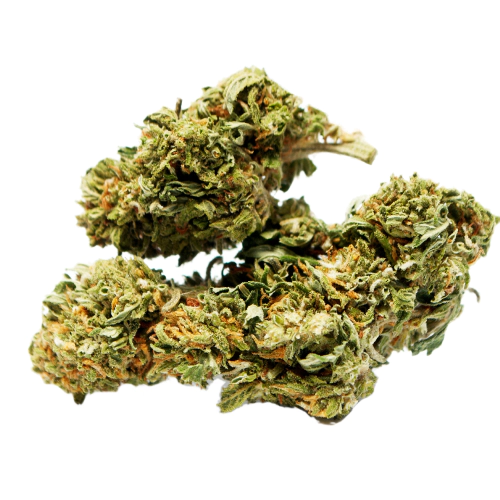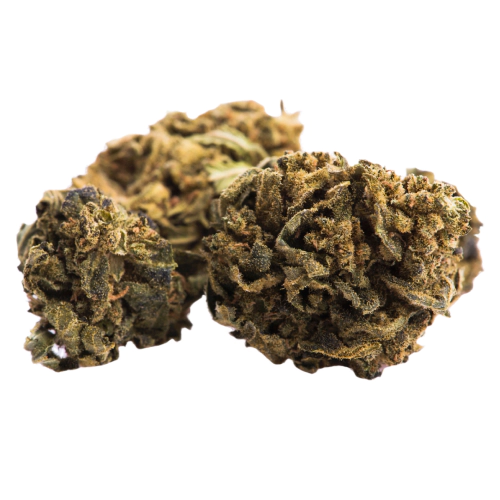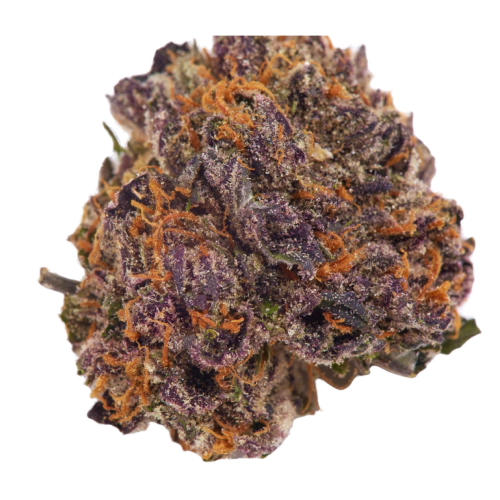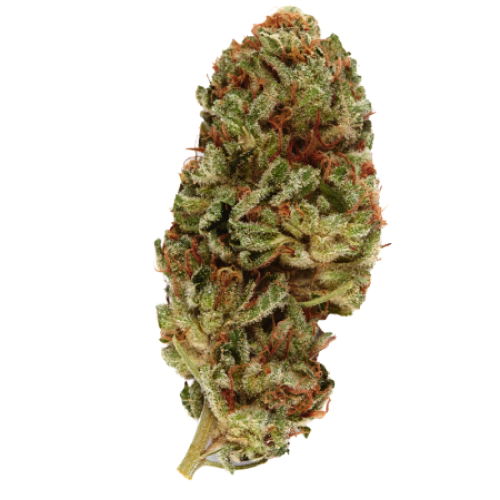Purple Punchsicle
Cannabinoid THC Dominant
THC 26 - 27%
CBD 0.58 - 0.8%
Effect Euphoric
Side Effect Drowsiness
Flavor Blueberry
Purple Punchsicle Strain
THC
CBD
Potency
Purple Punchsicle is an Indica-dominant hybrid strain of 65/35 that is bred by double-crossing the potent Purple Punch. The terpenes of this weed include Humulene, Myrcene, Limonene, and Linalool.
Purple Punchsicle strain contains THC levels between 26 and 27%, with a CBD range between 0.48 and 0.68%. This weed is best taken in the evening hours due to a high that offers a sleepy and relaxed chill that may leave you anchored to the sofa. High THC levels make this a better choice for more experienced users. It should be taken slowly regardless, as more than a bud may cause anxiety.
Taste and Smell
The aromatic profile of this marijuana strain is popular with users due to its pleasant fruity taste. The flavor is reminiscent of a blueberry muffin, with sweet blueberry mingling with hints of grape, berry, and just a whiff of citrus finish.
Information About Effects
This strain hits with a euphoric uplift that gently glides the user into a happily sedated state of mind.
The cheerful relaxation of this cannabis makes it a fine choice to help manage the symptoms of depression and stress. In addition, it's often used therapeutically by patients to manage the symptoms of arthritis. The sedation of Purple Punchsicle's high may also be used to help support sleepiness for those with insomnia.
Possible side effects of Purple Punchsicle include: Thirst or dry mouth, dry eyes, hunger, and hallucination
Growing Info
Growers can cultivate Purple Punchsicle strain either indoors or out. The flowering time is between 52 and 61 days, harvest time ready typically on day 57. Flowers are spade-shaped with rich purple foliage and studded with green trichomes. The plants grow 60-80 cm both indoors and out, with generous yields of between 1 and 2 oz per.
Side Effects
Simply let us know how this strain tastes or write a detailed review.
Purple Punchsicle Strain Cannabinoids
| THC | Tetrahydrocannabinol, or THC, is a major cannabis chemical compound. It is a psychoactive element that stimulates dopamine release and induces euphoria or happiness. THC-rich strains may be helpful with such conditions as lack of appetite, chronic pains , etc. It is considered to be the primary active marijuana component. | 26 - 27% |
| CBD | Cannabidiol, or CBD, is a major compound in cannabis, which is non-psychoactive. It is also proved to counteract the side effects of the second major component THC. CBD is widely used for medicinal purposes in rubs, oils and so on. It is helpful in muscle pain cases, may treat arthritis and migraines. Even Greeks used it against pain, while Queen Victoria applied it to get rid of menstrual cramps. | 0.58 - 0.8% |
| CBC | Cannabichromene, or CBC, is a minor cannabinoid, meaning that its quantity in cannabis is quite little. Though it has the same origin as CBD and THC, it is different in functions. Without any psychoactive effects, it is an efficient cannabis compound in combating acne and depression. CBC produces analgesic, antibacterial and anti-inflammatory effects. | 0.11 - 0.22% |
| CBG | Cannabigerol, or CBG, is one of the minor cannabis compounds in adult plants. On the other hand, young ones contain a lot of this antibacterial and anti-inflammatory component. During the growth, CBG is converted into different cannabinoids, mostly THC and CBD. The compound itself increases appetite and decreases eye pressure. | 0.02 - 0.05% |
| CBN | Cannabinol, or CBN, is a trace element in cannabis that is considered to be mildly psychoactive. It appears from oxidation THC, exposed to light and heat. CBN is mostly contained in old cannabis and in traditional hashish. It is effective against insomnia, bacterial infections and appetite loss. | 0.35 - 0.35% |
| THCV | Tetrahydrocannabivarin, or THC-V, is a compound contained in cannabis in trace amounts. Even though it is close to THC molecularly, it is different in effects. This compound may be psychoactive only in large amounts. THC-V reduces blood sugar, controls appetite, stimulates bone growth, etc. African Sativa strains are the richest in THC-V. | 0.1 - 0.22% |
Purple Punchsicle Terpene Profile
| Pinene | Pinene is one of the most widespread terpenes in nature, found in pine trees, basil, nutmeg, parsley, and rosemary. Cannabis containing terpene (alpha-pinene or α-pinene) boasts a strong pine scent. Pinene is responsible for anti-inflammatory, pain-relieving, and anti-anxiety effects. | 0.16% |
| Myrcene | Myrcene (also known as β-myrcene) is one of the most common terpenes found in cannabis, representing more than 20% of the modern marijuana terpene profile. Myrcene has a distinct earthy, musky flavor, resembling cloves. It is responsible for calming and soothing effects of weed. Myrcene is also found in hops, thyme, mango, lemongrass, guava melon. | 0.05% |
| Ocimene | Ocimene (derived from the Ancient Greek word Ocimum meaning basil) is a terpene with sweet and herbaceous flavors, also boasting citrusy and woody undertones. Naturally, ocimene occurs in mint, parsley, orchids, hops, kumquats, mangoes, basil, bergamot, lavender, and pepper. Offers antifungal, anti-inflammatory, and antiviral properties. | 0.14% |
| Humulene | Humulene (also known as α-humulene) is one of the major terpenes found in cannabis, contributing to woody, earthy, spicy, herbaceous, and, mainly, floral aromas of cannabis. Used in modern medicine, humulene offers anti-inflammatory, antibacterial, and appetite suppressant effects, which have been well-researched by pharmaceutical companies. | 0.16% |
| Limonene | Limonene (also known as d-limonene) is the second most common terpene in nature and the third most common terpene in cannabis. It has a powerful citrus aroma and can be found in all citruses, including lemons, oranges, grapefruits, limes, juniper, etc. Limonene is known to elevate moods and provide anxiety, depression, and stress relief. | 0.11% |
| Linalool | Linalool (also known as beta linalool, linalyl alcohol, linaloyl oxide, and p-linalool) is one of the rarest terpenes found in cannabis, mostly in small quantities. Linalool is known for its spicy and lavender aroma, bringing relaxation and calming effects. It is also said to provide anti-inflammatory and analgesic properties that can be useful for athletes. | 0.05% |
| Terpinolene | Terpinolene is one of the most common terpenes found in cannabis; however, It's usually presented in small quantities. Is responsible for piney, floral, herbaceous, and even a little bit citrusy aroma of cannabis. Terpinolene can be found in lilacs, nutmeg, and cumin. In cannabis, terpinolene contributes to the sensation of "freshness." Has the potential to reduce the risk of heart diseases. | 0.16% |
| Caryophyllene | Caryophyllene (also known as beta or b caryophyllene) is a terpene found in many herbs and spices, such as black pepper, basil, rosemary, and oregano. Cannabis high in caryophyllene delivers a strong spicy, peppery aroma, resembling cinnamon and cloves. Caryophyllene offers potent anti-inflammatory and sedative effects. | 0.16% |
| Total terpenes content | 0.99% |
Growing Info
Similar Strains
THC 23 - 27%
CBD 0.17 - 0.4%
Effect Euphoric
Flavor Spicyherbal
THC 15 - 15%
CBD 0.39 - 0.49%
Effect Uplifted
Flavor Tea
THC 18 - 20.2%
CBD 0.49 - 0.76%
Effect Relaxed
Flavor Spicyherbal
THC 5 - 8%
CBD 0.05 - 0.58%
Effect Tingly
Flavor Lime
THC 15 - 20%
CBD 0.47 - 0.65%
Effect Energetic
Flavor Spicyherbal
THC 18 - 18%
CBD 0.59 - 0.75%
Effect Uplifted
Flavor Flowery
THC 21 - 23%
CBD 0.67 - 0.78%
Effect Relaxed
Flavor Nutty
THC 21 - 25%
CBD 0.97 - 1.26%
Effect Tingly
Flavor Strawberry
THC 18 - 22%
CBD 0.32 - 1.15%
Effect Giggly
Flavor Coffee
THC 8 - 8%
CBD 0.99 - 1.11%
Effect Happy
Flavor Mint











Be the first and share your opinion
Write a Review